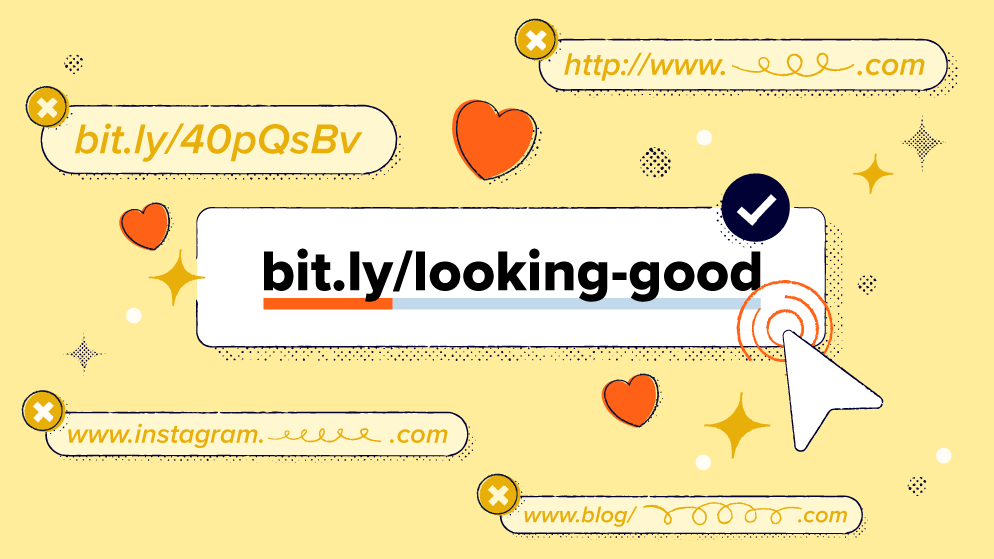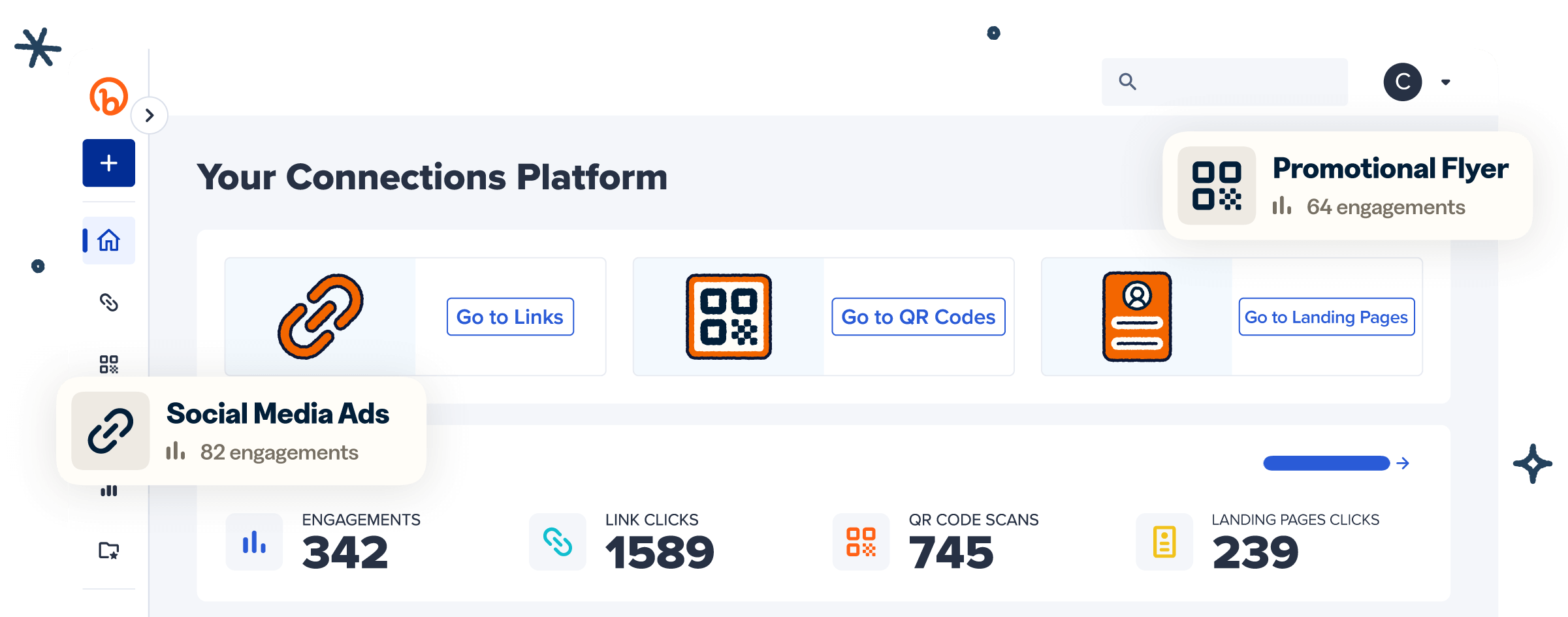Despite the name, there’s nothing vain about them—vanity URLs are a popular way to increase a company’s digital presence and focus its branding.
These short, portable links can be used in marketing campaigns, marketing materials, email campaigns, social media posts, and anywhere else a brand might use links.
Below you’ll learn everything you need to know about vanity URLs—and how your brand can leverage them to improve your marketing efforts.
What is a vanity URL?
A vanity link, also known as a custom short URL, takes a long, descriptive URL and turns it into a shorter, customized URL that is still descriptive of the related page but smaller in size. Vanity URLs usually include a brand name.
A vanity URL is used to help people easily remember a specific web address. These URLs often redirect to another longer URL that contains tracking information.
Learn how to create a vanity URL in four easy steps with Bitly.
Custom URL vs. vanity URL
Vanity URLs and custom URLs are more or less the same thing. Technically, you could create a custom URL for some other (non-vanity) purpose. But the vast majority of the custom short links we see created through Bitly are for marketing purposes. They’re essentially functioning like a vanity plate—hence the term “vanity URL.”
Vanity URL examples
Vanity URLs are easier to understand once you see them in action, so let’s look at a few examples, starting with ourselves.
At Bitly, we often promote our Enterprise product. But the URLs can become quite long once we add tracking information, so we created a vanity URL that can help users easily remember (and type) the URL.
Here is an example of a vanity URL that we use to promote Bitly Enterprise: 862735.7lwjx.group/enterprise.
Now we can use this vanity site on marketing materials both offline and online. Users can easily remember the URL, and we can add whatever tracking or redirects we need on the back end.
It’s much easier to remember our vanity URL than something like this long URL:
https://862735.7lwjx.group/pages/landing/get-enterprise?utm_content=site-enterprise-button&utm_source=bitly-blog&utm_medium=referral&utm_campaign=blog-vanity-url
A vanity URL or branded URL is a chance to get creative with your brand. Think about it—your brand shares links in nearly every customer communication, whether it’s via email, on social media, on your website, or elsewhere.
So every time you share a link, there’s an opportunity to place your brand front and center in your digital communications.
What is a vanity domain name?
To start sharing vanity URLs, you need a vanity domain. A vanity domain name is a similar concept as a vanity website, except its focus is on the front part of the URL. The domain name is the 862735.7lwjx.group part of this URL: https://862735.7lwjx.group/.
You can use a vanity domain name as an alternative to your default domain to help promote your brand via social media, mobile devices, and offline materials.
At Bitly, we call these domains “custom domains.”
When you are considering creating a vanity domain name or custom branded domain, you’ll want to ask yourself:
- How does the domain name look aesthetically? Is it concise enough, while still easy to read?
- Does the domain name communicate the value proposition of our brand?
- Will people be able to associate our domain name with our brand?
- Is it catchy and easy to remember?
How do you make your own vanity URL using Bitly?
Creating your own vanity URL and custom domain with Bitly is easy! Just follow the steps below and you’ll be up and running with your own vanity URL in no time.
Set up your custom domain
The first thing you’ll want to do is decide what custom domain you want to use—if you don’t already have one. There are many different domain endings to consider, such as:
- .link
- .xyz
- .audio
- .gift
- .tv
For example, our marketing team at Bitly uses “bitly.is” as our custom domain. Depending on what your business is all about, you might choose a custom domain name like sliceo.pizza, sneakr.life or delivr.today.
To set up your custom domain in Bitly, log into Bitly using an admin account and follow these steps:
1. Select Settings in the sidebar along the left side of the screen.
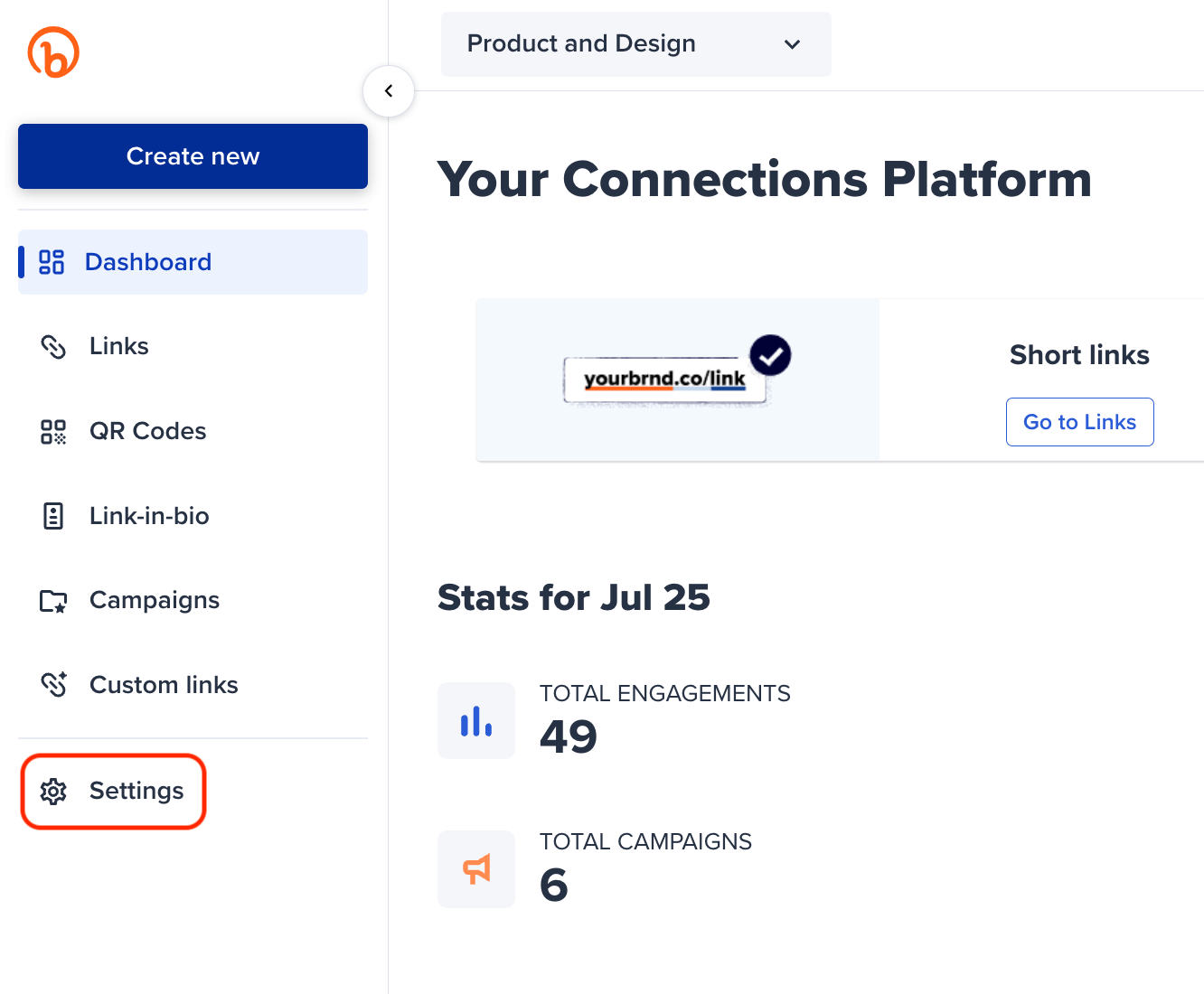
2. Select Custom domains, which appears under Account settings menu.

3. Select Add a Domain.

4. Choose I want to use my own domain.
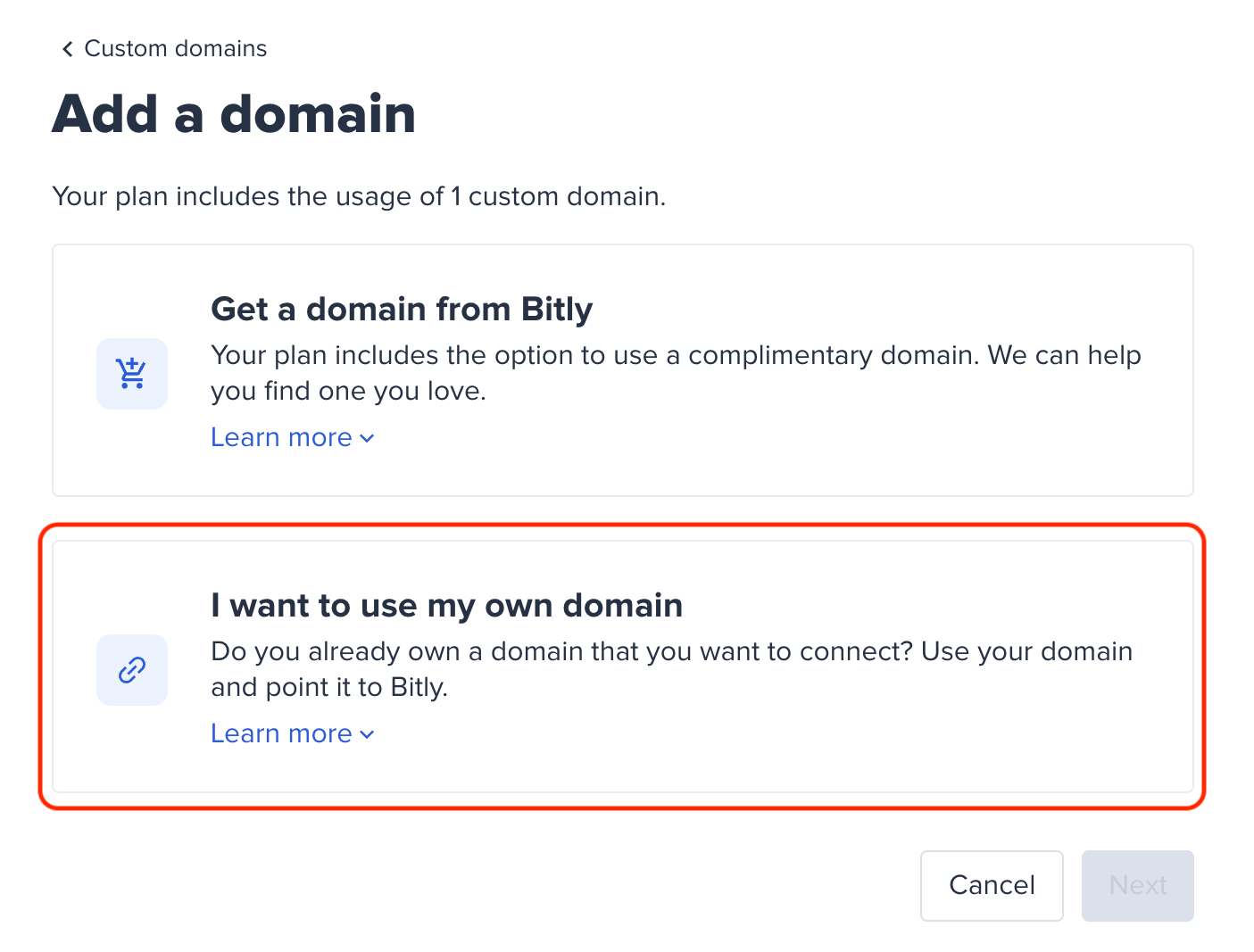
5. Enter the custom domain you’d like to use.
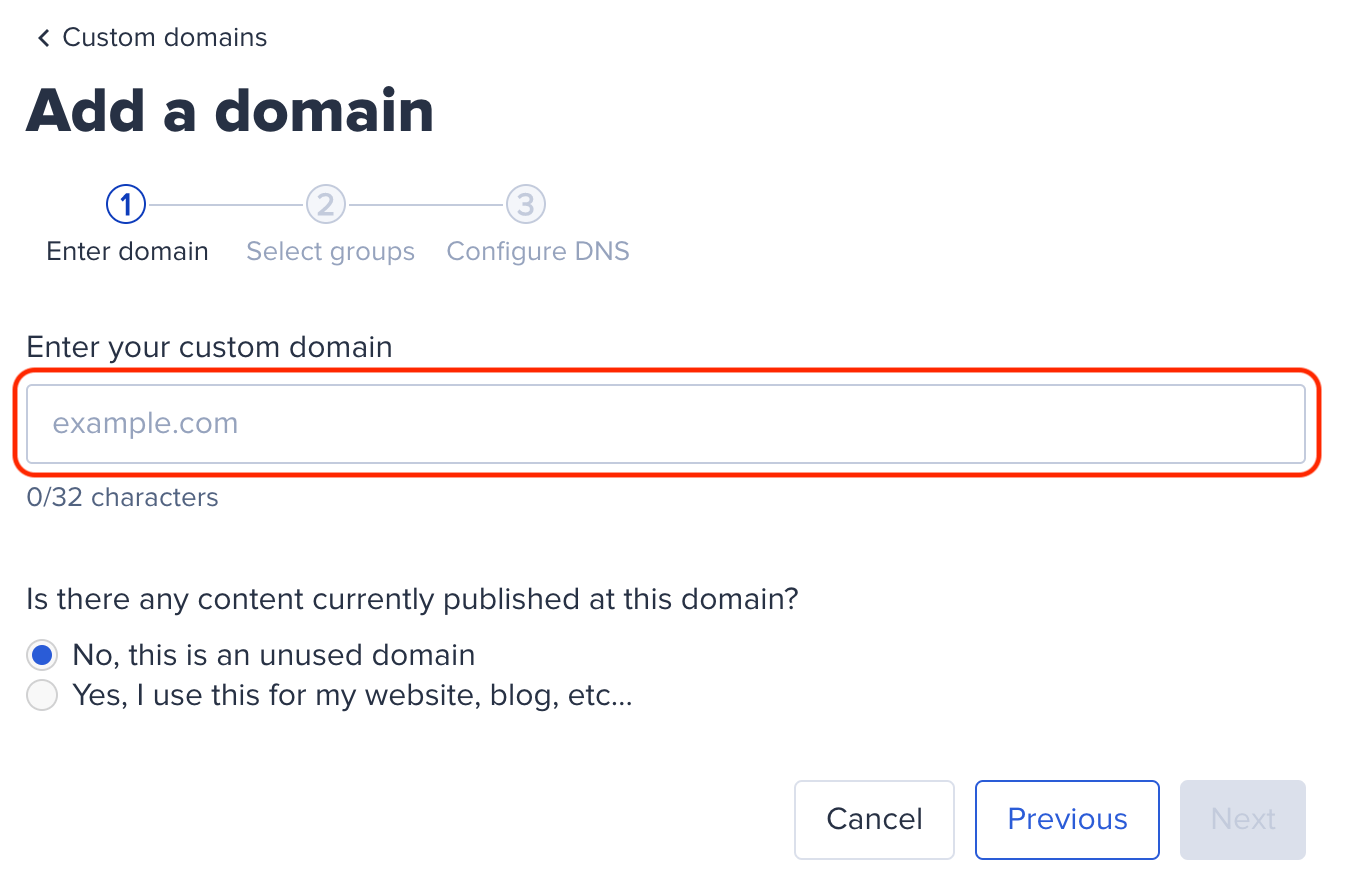
6. Choose whether or not this is an unused domain, or if it will be a subdomain.
7. Select the group(s) where you plan to use this domain to shorten links.
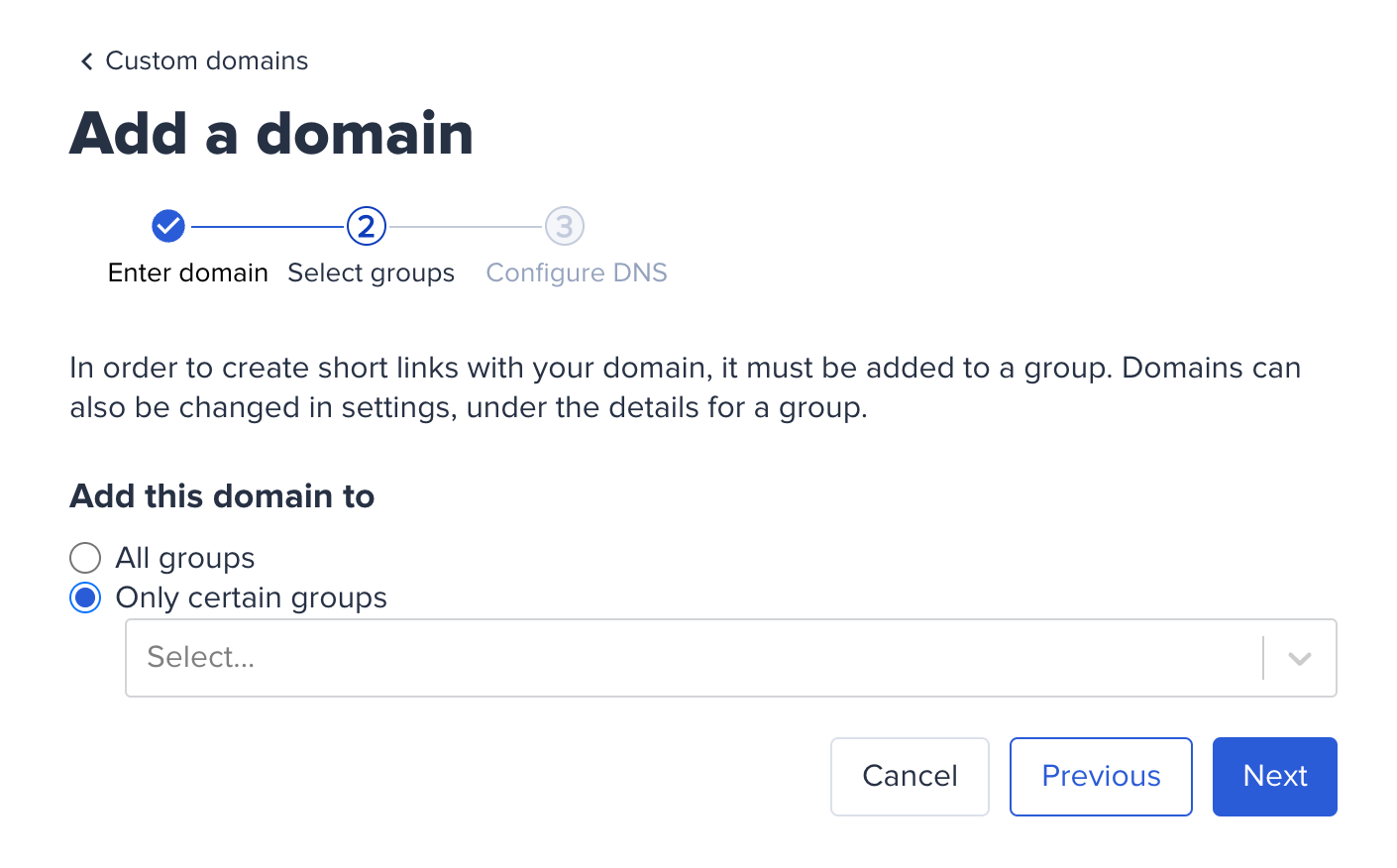
8. Click Next and get ready to configure your DNS settings.
Configure your DNS settings
Now that you’ve purchased your domain and added your custom domain to Bitly, the setup is nearly complete. The last step you need to take is to configure your DNS for your Bitly account.
The way you’ll do this varies depending on who your domain registrar is and whether you’re setting up your DNS settings for an entire domain or just a subdomain.
The process generally looks like this, though you may need to modify some steps based on your domain registrar’s instructions.
First, log in to your domain registrar’s website and select the domain or subdomain you want to modify.
Next, look for the section where your DNS entries are stored. This might be called “DNS Configuration” or “Advanced DNS,” among other phrases.
The next step depends on if you’re configuring an entire domain or just a subdomain.
- If you’re configuring an entire domain, look for the A Records. Set the hostname for any A Records to @, and then set the IP addresses to 67.199.248.12 and 67.199.248.13. Remove any other A Records.
- If you’re configuring a subdomain, edit the CNAME (or add one). The hostname is whatever your subdomain is (like “support” in support.862735.7lwjx.group), and you want that to point to cname.862735.7lwjx.group.
(Tip: if these brief instructions didn’t provide enough context, visit our full support article on how to configure your DNS for your Bitly account.)
Once you’ve completed setup and configured your DNS settings, when you go to shorten a new link, you’ll be able to see your custom domain in the dropdown menu below your link. Here’s what the dropdown in our team’s account looks like:
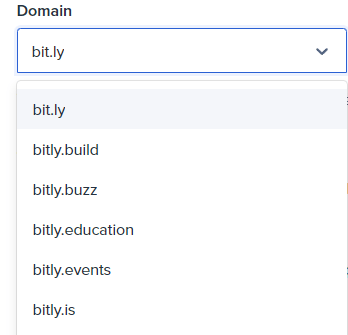
How to create a vanity URL
With Bitly, making your own vanity URL is simple. When you create a link using Bitly, you can set the custom back-half (that’s the vanity URL portion of your link) at the exact same time. You’ll find it under Ways to share; Custom back-half (optional):
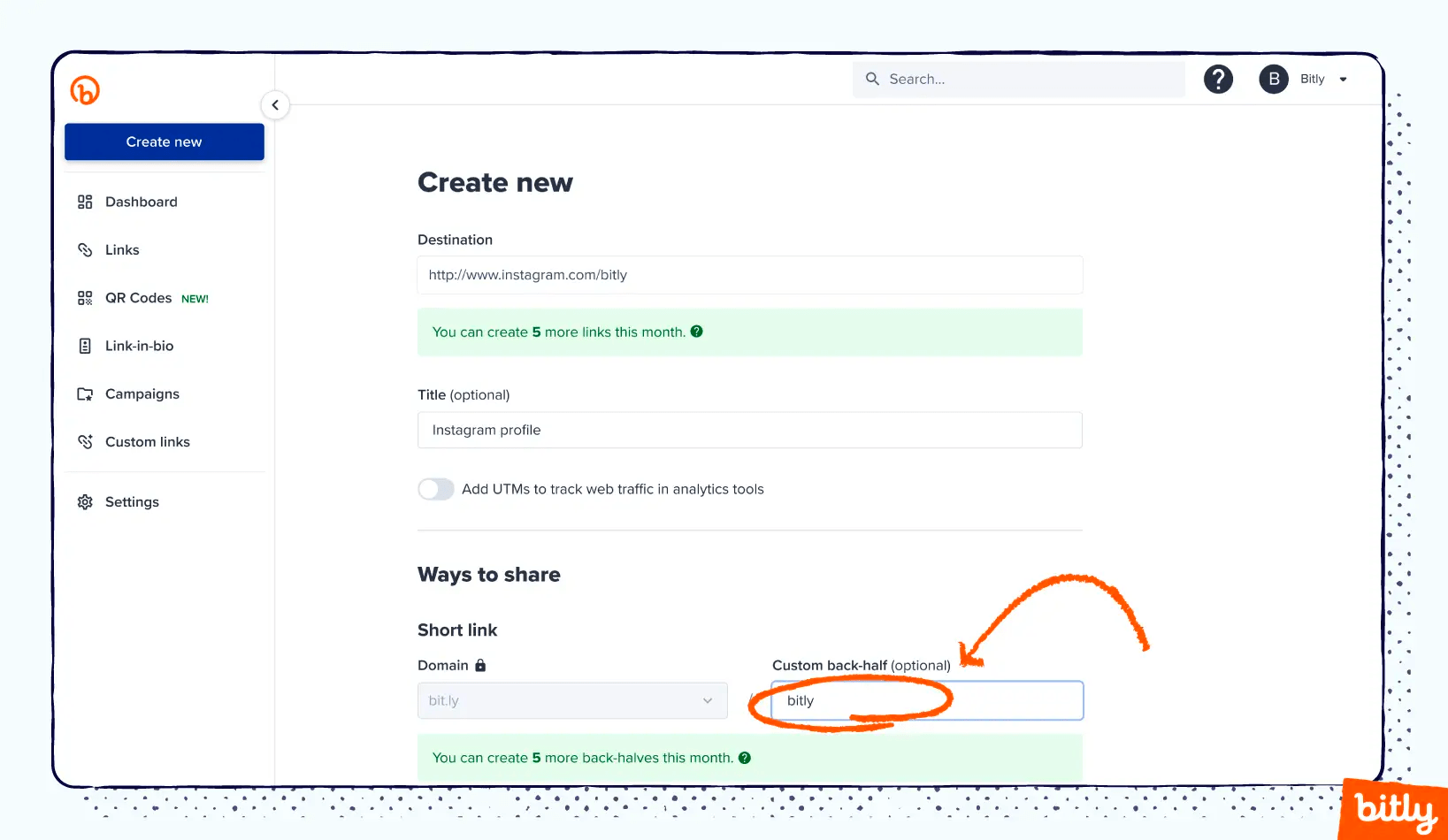
If you want to turn an existing Bitly link into a vanity URL, you can do that, too: just use Bitly to edit the link, and you can customize the back-half right there in Bitly.
Now you have your own vanity URL to use in your marketing materials.
It’s that simple!
Is there a connection between vanity URLs and SEO?
The short answer is yes, vanity URLs affect SEO (search engine optimization).
That said, much like any other element tied to SEO, the extent to which a vanity URL can impact SEO is debated and subject to change.
The SEO experts at Moz state that there are three main benefits of URLs.
- Improved user experience: URLs can help humans, as well as robots (the search engines), understand what a page will be about before they select it.
- Rankings: Search engines take keywords used within a URL into consideration when determining a page’s relevance to a user’s search query.
- Links: They show people where you’re sending them.
There is some evidence suggesting that using 301 redirects helps retain the “SEO juice” of an original page. By using a 301 redirect, you’ll pass “ranking power” from one URL to the other.
A 301 redirect is the most efficient and search-engine-friendly method for webpage redirection. Because Bitly doesn’t reuse or modify links, we consider our vanity URL redirects to be permanent.
Bitly links also track data on every click, tap, and swipe, such as total clicks and information on referral traffic and location.
Tips for vanity links and SEO practices
Using Bitly makes it much easier to follow vanity URL best practices, ensuring your vanity URLs help and don’t harm your SEO efforts.
From a pure marketing perspective, you’ll also want to make sure that your vanity URL is easy to read and pronounce. Including a call-to-action (CTA) and an SEO-strategic keyword are two other smart moves (when doing so is feasible).
Consider these additional best practices as well:
Capitalization is key
Capitalizing the first letter of each word in your vanity URL makes those URLs easier to read and remember.
Before you get carried away, just remember that case does matter in URL back-halves. Your domain can be capitalized any way you like, but your brand.co/PaGe is not the same thing as yourbrand.co/PAGE or yourbrand.co/page.
If you’re using vanity URLs with back halves in ways where you expect people will manually type them into a browser, make sure your back halves stay consistent.
Don’t use special symbols
Em dashes, currency designations, and other special characters may look interesting, but your audience may neglect to type them (or not be able to, depending on region and device). Then they likely won’t ever get to your page.
Shorter is better
Some ad platforms have length requirements and may not accept your vanity URL if it’s too long. Some research from Backlinko also indicates that shorter URLs perform better in search engine ranking pages (SERP) than longer ones do.
Know when not to use vanity domains
At Bitly, we believe in the services we offer, but we also know that not every project requires a vanity URL. Vanity domains are a great investment if you need to keep using short links on a consistent basis, but smaller businesses can get by using vanity URLs for only major events that require you to shore up more attention.
Benefits of using a vanity URL
Vanity URLs are powerful marketing assets that deliver value in numerous ways, enhancing your brand’s efforts on multiple fronts, and here’s why.
People trust vanity URLs
First, people tend to trust vanity URLs. They “look like” your brand, which makes them instantly familiar in a way that a standard short link isn’t.
Boosted clicks
Because people trust them, vanity URLs also tend to get more clicks than long, hard-to-read URLs or unfamiliar-looking short links. And more clicks = more conversions!
They show your audience where you’re sending them
By using both a custom domain and a custom back-half, you can show your audience both your brand identity (yourbrand.co) and something about where they’ll end up if they select (/SummerBOGO).
Increased brand awareness
Establishing brand awareness is vital in today’s competitive, noisy landscape. You’ve already invested in a website, a logo, and a visual identity—and a vanity URL becomes an extension of all three.
Easy shareability
Short, simple vanity URLs are easy to copy, paste, and share. They don’t run into character limits on social media, and they don’t clutter up captions or ad copy.
Create a memorable vanity URL with Bitly
Vanity URLs are a powerful way to communicate a lot about your brand in a short amount of characters. They increase trust, clickthroughs, clarity, brand awareness, and shareability.
Our take: Vanity URLs are a no-brainer for businesses with an active online presence.
Bitly makes creating vanity URLs as simple as possible. With Bitly, you can create custom back-halves and custom domains, combining them to create whatever vanity links you need.
